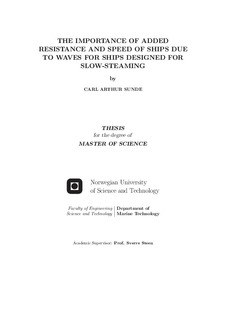| dc.description.abstract | In the recent years the greenhouse effect in the atmosphere has become much stronger because of emissions of greenhouse gases on the earth. One of these gases is CO2. This may come from combustion of fossil fuel. The international shipping fleet emitted 1046 million tons of CO2 in 2007, which corresponds to 3.3% of all CO2 emission in the world. The increase intensity of the greenhouse effect leads to global warming, which can affect the human life heavily. Ice melts, sea level increase, lands will disappear in the water, lead to heat waves, starving people, more widespread of infections, and etc. Because of this there have to be a reduction of these greenhouse gases soon. The ship fleet is expected to grow in the coming years, so the only way to reduce the emissions is to manage a strong reduction for each vessel. There have been many ideas around this, and one up and coming is Slow Steaming. This is that the vessel is reducing the velocity, which corresponds to reduced necessary break power, which may reduce the emissions. One ship operator which have tried out the slow steaming concept is The A.P. Moller Marsk group. They have slowed down the speed on some of their container vessels from 25 knots to 20 knots (slow steaming) and also tried out 12 knots(super slow steaming). They have by reduced the speed to the half, reduced the fuel consumption and greenhouse gas emissions by 30%. But to compensate for reduced service frequency there are two options: Increase cargo capacity of the vessels or put in additional vessels on the route. Both options are reducing the profit, both environmental and economical.
In this master thesis there has been performed a case study to look closer to the power prediction when reducing the velocity. Three vessels have been analyzed: a VLCC, a chemical tanker and a container vessel. These have been analyzed in the hydrodynamic workbench ShipX. A route from Le-Havre in Europe to Charleston in America has been applied in ShipX. Since waves are important in break power predictions due to added resistance, both summer season and winter season have been analyzed. The resistance was predicted by the empirical methods Holtrop 84, while the added resistance was calculated by using Gerritsma & Beukelman’s method. For each velocity and each vessel was it calculated an optimal propeller (Wageningen B-series). As expected the break power increased exponential for increasing speed for all three vessels in calm water condition, summer season and winter season. But when I looked closer to an added factor, which is the proportion between break power respectively in summer/winter season over calm water, this was largest for low speeds and decreased when the speed was increased. This means relatively the wave contribution of necessary break power is largest for low speeds. An example of this is that for four to six knots with the container vessel, the break power in calm water had to be multiplied by 2.2 (120% increase) to get real break power in summer waves. The added factor for 24 knots was only 1.21 (21% increase).
When it comes to optimum speed for a vessel, realistic weather conditions have a strong influence here. In realistic weather both size of waves and direction of waves are varying. If the ship is traveling in small waves, the optimum speed will be much higher than if it’s going in rough sea states. There is also big difference if there is head sea, beam sea or following sea. Other factor for finding an optimum speed for a vessel is economic (profit versus costs), value and durability of cargo, demand of transportation, engine performance and etc. | nb_NO |
